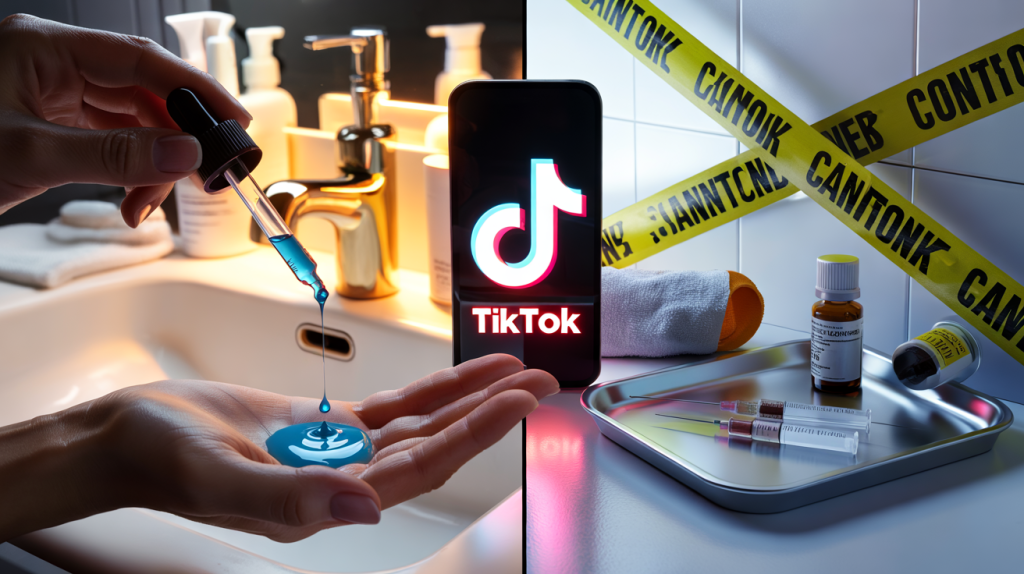Peptide stacking has exploded on TikTok feeds, promising faster muscle recovery, tighter skin, and weight loss in one neat routine. The format is simple, the claims move fast, and the results look instant on camera.
Here is the frame that matters. TikTok passed 1 billion monthly active users in September 2021, which means health trends can leap from niche to mainstream in hours (TikTok Newsroom, 27 September 2021). At the same time, several peptides that appear in stacks are either prescription drugs, unapproved products, or substances restricted in sport, a point that changes the story the moment it is said out loud.
Peptide stacking on TikTok, explained without the fluff
The term describes the practice of combining two or more peptides to target different goals at once, often skin and body composition. One clip shows a night routine with a copper peptide serum and a retinol alternative. Another shows injections for recovery, then a dose for sleep. A stack looks curated, like a playlist.
The appeal has a logic. Peptides are short chains of amino acids, and some are used in approved medicines. Semaglutide, a peptide, received United States approval for chronic weight management on 4 June 2021 under the brand Wegovy (U.S. Food and Drug Administration). That green light feeds the perception that other peptides must be close behind.
But the label on a specific product matters. BPC 157, frequently named in stacks online, is not an FDA approved drug. A search of the Drugs@FDA database shows no approved application for BPC 157 as of October 2024. That single detail changes the legal and safety context for buyers who discover it via a short video.
What the rules and studies actually say about peptides
Regulators and sports authorities have staked clear lines. The World Anti Doping Agency lists growth hormone releasing peptides, including GHRPs and secretagogues such as ipamorelin and tesamorelin, as prohibited at all times in its 2024 Prohibited List. For any athlete, recreational or elite, a casual stack can trigger a violation with consequences that last years.
Clinical evidence is not moving at viral speed. The landmark STEP 1 trial reported a mean body weight reduction of about 14.9 percent with semaglutide at 68 weeks versus 2.4 percent with placebo, in adults with obesity and without diabetes, published in 2021 in the New England Journal of Medicine. That is strong evidence for one prescription peptide under medical supervision, not a green light for do it yourself blending of unapproved compounds.
Topical cosmetic peptides live in a different lane. Small trials and brand funded studies have suggested improvements in skin texture or fine lines after several weeks of daily use, but sample sizes have often been modest and endpoints vary by study. Marketing sometimes compresses that nuance into a before and after that looks definitive. It is not.
Supply adds another layer. When a compound is unapproved, quality can vary lot to lot, and labeling may be incomplete. The result is uncertainty about purity or dose, which defeats the whole point of a carefully planned stack. That uncertainty is rarely visible in a 30 second clip.
How to read a viral peptide stack without getting burned
A TikTok stack that mixes topical skincare and prescription grade injections wraps two separate worlds into one routine. The rules, the evidence, the way products are dispensed, all differ. Watching with that split view reduces the chance of a costly mistake.
When a video names a prescription peptide, check whether the product mentioned is approved in the country where it is sold, and for which indication, and on what date. The Wegovy approval date in 2021 provides a model for that kind of verification. It also shows why off label enthusiasm rarely matches on label evidence. A claim that a compound like BPC 157 speeds tendon repair may circulate widely online, while the regulatory file still reads empty.
Athletes should cross check any stack ingredient against the World Anti Doping Agency 2024 list before purchase. That single step often flips the decision. It also matters for fitness creators, because an undisclosed prohibited substance creates a reputational and practical risk if followers copy the routine.
Skincare stacks are different again. Many copper peptide serums or signal peptide creams are cosmetics, not drugs, and are sold over the counter. That status constrains what claims are substantiated. Timelines are key. Most cosmetic studies that report visible change talk in weeks, often 8 to 12, not overnight, and results can plateau. A video that implies day one transformation is entertaining, definitly, but it does not match the way skin biology usually responds.
There is also the simple question of stacking for stacking’s sake. If two products target the same pathway, combining them can add cost without adding effect, and may raise irritation risk for skin. In the injectable world, stacking can compound side effects or interactions, especially when sources are unclear or dosing is improvised.
For those who still want to explore this trend, the missing piece is a checkpoint before the basket clicks buy. Confirm the legal status of each peptide through official databases, read the latest WADA list if sport is on the table, and match any bold promise to a peer reviewed study with numbers and dates. That quiet cross check keeps the benefits of TikTok speed while restoring the safety net that short video often leaves out.
